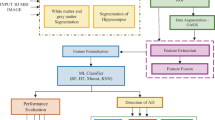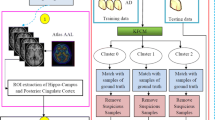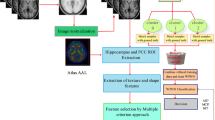Abstract
Alzheimer’s disease (AD) is considered to be one of the most frequent neurogenerative dementia in the elderly population. In order to improve the quality of life span, early detection of AD has drawn significant attention to the researchers throughout the globe. To this aim, this paper makes a novel attempt to classify the brain MRI images into three classes viz. Alzheimer’s disease (AD), mild cognitive impairment (MCI) and healthy control (HC) using the volumetric information of white matter (WM), grey matter (GM) and cerebro spinal fluid (CSF). This classification has been accomplished with the help of fuzzy logic based approach followed by a majority voter classifier. Our proposition is finally tested over several brain MRI images collected from ADNI dataset. Supremacy of our proposition has strongly been established by measuring its performance parameters such as accuracy, sensitivity and specificity and subsequently been compared with many of the state-of-the-art methods. Simulation results have shown an average improvement of approximately 6.5%, 6.9% and 4% over a number of existing works in terms of accuracy, sensitivity and specificity respectively.










Similar content being viewed by others
References
Ashburner J, Friston KJ (2000) Voxel-based morphometry—the methods. Neuroimage 11(6):805–821
Basaia S, Agosta F , Wagner L, Canu E, Magnani R, Santangelo M, Filippi ADN (2019) Initiative, et al, Automated classification of alzheimer’s disease and mild cognitive impairment using a single mri and deep neural networks. NeuroImage Clin 21:101645
Bateman RJ, Aisen PS, De Strooper B, Fox NC, Lemere CA, Ringman JM, Salloway S, Sperling RA, Windisch M, Xiong C (2011) Autosomal-dominant alzheimer’s disease: a review and proposal for the prevention of alzheimer’s disease. Alzheimer’s Res Ther 3(1):1–13
Chandra A, Mondal S (2017) Amalgamation of iterative double automated thresholding and morphological filtering: a new proposition in the early detection of cerebral aneurysm. Multimed Tools Appl 76(22):23957–23979
Chandra A, Roy S (2021) On the detection of alzheimer’s disease using support vector machine based majority voter classifier. In: 2021 8th International conference on signal processing and integrated networks (SPIN). IEEE, pp 144–149
Chandra A, Roy S (2021) Difference between alzheimer’s disease and mild cognitive impairment: Ztest based study. In: proceedings of 2nd International Conference on Applied Electromagnetics, Signal Processing and Communication (AESPC 2021) IEEE
Demirhan A, Nir TM, Zavaliangos-Petropulu A, Jack CR, Weiner MW , Bernstein MA, Thompson PM, Jahanshad N (2015) Feature selection improves the accuracy of classifying alzheimer disease using diffusion tensor images. IEEE
Feng C, Elazab A, Yang P, Wang T, Zhou F, Hu H, Xiao X, Lei B (2019) Deep learning framework for alzheimer’s disease diagnosis via 3d-cnn and fsbi-lstm. IEEE Access 7:63605–63618
Frozza RL, Lourenco MV, De Felice FG (2018) Challenges for alzheimer’s disease therapy: insights from novel mechanisms beyond memory defects. Front Neurosci 12:37
Garg D, Garg NK, Kumar M (2018) Underwater image enhancement using blending of clahe and percentile methodologies. Multimed Tools Appl 77 (20):26545–26561
Ghosh S, Chandra A, Mudi RK (2019) A novel fuzzy pixel intensity correlation based segmentation algorithm for early detection of alzheimer’s disease. Multimed Tools Appl 78(9):12465–12489
Gupta S, Kumar M, Garg A (2019) Improved object recognition results using sift and orb feature detector. Multimed Tools Appl 78(23):34157–34171
Gupta S, Thakur K, Kumar M (2020) 2D-human face recognition using sift and surf descriptors of face’s feature regions, The Visual Computer, pp 1–10
Haouas I, Moussa H, Douik A (2021) Classification and identification of alzheimer disease with fuzzy logic method. In: 2021 IEEE International Conference on Design & Test of Integrated Micro & Nano-Systems (DTS). IEEE, pp 1–6
Khvostikov A, Aderghal K, Benois-Pineau J, Krylov A, Catheline G (2018) 3d cnn-based classification using smri and md-dti images for alzheimer disease studies, arXiv:1801.05968
Konar A (2006) Computational intelligence: principles, techniques and applications Springer Science & Business Media
Krashenyi I, Popov A, Ramirez J, Gorriz JM (2015) Application of fuzzy logic for alzheimer’s disease diagnosis. In: 2015 Signal Processing Symposium (SPSympo). IEEE, pp 1–4
Krashenyi I, Popov A, Ramirez J, Gorriz JM (2016) Fuzzy computer-aided diagnosis of alzheimer’s disease using mri and pet statistical features. In: 2016 IEEE 36th International Conference on Electronics and Nanotechnology (ELNANO). IEEE, pp 187–191
Lee B, Ellahi W, Choi JY (2019) Using deep cnn with data permutation scheme for classification of alzheimer’s disease in structural magnetic resonance imaging (smri). IEICE Trans Inf Syst 102(7):1384–1395
Li F, Liu M, Initiative ADN et al (2019) A hybrid convolutional and recurrent neural network for hippocampus analysis in alzheimer’s disease. J Neurosci Methods 323:108–118
Lian C, Liu M, Zhang J, Shen D (2018) Hierarchical fully convolutional network for joint atrophy localization and alzheimer’s disease diagnosis using structural mri. IEEE Trans Pattern Anal Mach Intell 42(4):880–893
Litjens G, Kooi T, Bejnordi BE, Setio AAA, Ciompi F, Ghafoorian M, Van Der Laak JA, Van Ginneken B, Sánchez CI (2017) A survey on deep learning in medical image analysis. Med Image Anal 42:60–88
Liu M, Cheng D, Wang K, Wang Y (2018) Multi-modality cascaded convolutional neural networks for alzheimer’s disease diagnosis. Neuroinformatics 16(3):295–308
Ma X, Li Z, Jing B, Liu H, Li D, Li H, Initiative ADN et al (2016) Identify the atrophy of alzheimer’s disease, mild cognitive impairment and normal aging using morphometric mri analysis. Front Aging Neurosci 8:243
Manjón JV, Coupé P (2016) Volbrain: An online mri brain volumetry system. Front Neuroinform 10:30
NP KT, Varghese D (2018) A novel approach for diagnosing alzheimer’s disease using svm. In: 2018 2nd International Conference on Trends in Electronics and Informatics (ICOEI). IEEE, pp 895–898
Patterson C (2018) The state of the art of dementia research: New frontiers, World Alzheimer Report, vol 2018
Rutegård MK, Båtsman M, Axelsson J, Brynolfsson P, Brännström F, Rutegård J, Ljuslinder I, Blomqvist L, Palmqvist R, Rutegård M. et al (2019) Pet/mri and pet/ct hybrid imaging of rectal cancer–description and initial observations from the rectopet (rectal cancer trial on pet/mri/ct) study. Cancer Imaging 19(1):1–9
Sadeghi N, Foster NL, Wang AY, Minoshima S, Lieberman AP, Tasdizen T (2008) Automatic classification of alzheimer’s disease vs. frontotemporal dementia: A spatial decision tree approach with fdg-pet. In: 2008 5th IEEE International Symposium on Biomedical Imaging: From Nano to Macro,. IEEE, pp 408–411
Shi J, Zheng X, Li Y, Zhang Q, Ying S (2017) Multimodal neuroimaging feature learning with multimodal stacked deep polynomial networks for diagnosis of alzheimer’s disease. IEEE J Biomed Health Inform 22(1):173–183
Telagarapu P, Mohanty B, Anandh K (2018) Analysis of alzheimer condition in t1-weighted mr images using texture features and k-nn classifier. In: 2018 international CET conference on control, communication, and computing (IC4). IEEE, pp 331–334
Valverde S, Oliver A, Roura E, González-Villà S, Pareto D, Vilanova JC, Ramió-Torrentà L, Rovira À, Lladó X (2017) Automated tissue segmentation of mr brain images in the presence of white matter lesions. Med Image Anal 35:446–457
Yushkevich PA, Piven J, Cody Hazlett H, Gimpel Smith R, Ho S, Gee JC, Gerig G (2006) User-guided 3D active contour segmentation of anatomical structures: Significantly improved efficiency and reliability. Neuroimage 31(3):1116–1128
Zekri F, Ghorbel H, Bouaziz R (2014) A decision support system based on fuzzy specialized rules for the alzheimer disease. In: 2014 11th International Conference on Fuzzy Systems and Knowledge Discovery (FSKD). IEEE, pp 490–496
Funding
This research work is funded by Ministry of Electronics & Information Technology, Govt. of India under Sir Visvesvaraya Young Faculty Research Fellowship (YFRF) scheme (Unique Awardee No. MEITY-PHD-3191).
Author information
Authors and Affiliations
Corresponding author
Ethics declarations
Conflicts of interest/Competing interests
The authors declare that they have no conflicts of interest/competing interests.
Additional information
Publisher’s note
Springer Nature remains neutral with regard to jurisdictional claims in published maps and institutional affiliations.
Rights and permissions
About this article
Cite this article
Roy, S., Chandra, A. On the detection of Alzheimer’s disease using fuzzy logic based majority voter classifier. Multimed Tools Appl 81, 43145–43161 (2022). https://doi.org/10.1007/s11042-022-13184-5
Received:
Revised:
Accepted:
Published:
Issue Date:
DOI: https://doi.org/10.1007/s11042-022-13184-5




